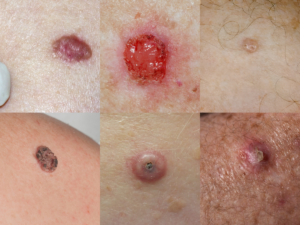Skin cancer is one of the most prevalent forms of cancer globally, affecting millions of people each year. Despite its common occurrence, many individuals lack a comprehensive understanding of this disease, its types, symptoms, and risk factors. In this guide, we delve into the intricacies of skin cancer to equip you with the knowledge needed for prevention and early detection.
Types of Skin Cancer
Melanoma
Melanoma is the deadliest form of skin cancer, originating from melanocytes, the pigment-producing cells of the skin. This type of cancer can develop anywhere on the body, even in areas not exposed to the sun. It often appears as an irregularly shaped mole with uneven borders and varying colors. As workplace skin checks become more common, early detection of melanoma has improved significantly, enhancing survival rates.
Non-Melanoma
Non-melanoma skin cancer comprises two main types: basal cell carcinoma (BCC) and squamous cell carcinoma (SCC).
- Basal Cell Carcinoma (BCC)
- is the most prevalent form of skin cancer, typically appearing as a shiny or pearly bump on the skin.
- Squamous Cell Carcinoma (SCC)
- often manifests as a red, scaly patch, which may bleed or crust over. While non-melanoma skin cancers are less deadly than melanoma, early detection through workplace skin checks is still crucial for effective treatment.
Symptoms of Skin Cancer
Skin cancer can present with various symptoms, each indicating a potential threat to one’s health.
Changes in Moles
One of the most common symptoms of skin cancer is changes in existing moles or the development of new ones. Look out for moles that are asymmetrical, have irregular borders, exhibit multiple colors, or have a diameter larger than a pencil eraser. Workplace skin checks can help monitor these changes regularly.
Persistent Sores or Lesions
Skin cancer may manifest as persistent sores or lesions that don’t heal within a few weeks. These sores may ooze, crust, or bleed, indicating a potential malignancy.
Itchy or Painful Patches
Patches of skin that itch, hurt, or cause discomfort should be examined closely, as they could be indicative of skin cancer.
Changes in Skin Texture or Color
Changes in the texture or color of the skin, such as darkening or reddening, should not be ignored, especially if they occur suddenly or without apparent cause.
Unusual Growth or Spots
Any unusual growths or spots on the skin, regardless of size, should be evaluated by a dermatologist, particularly if they exhibit rapid growth or irregular characteristics.

Suspicious moles and lesions that could indicate skin cancer.
Risk Factors for Skin Cancer
Understanding the risk factors associated with skin cancer is crucial for prevention and early detection.
Ultraviolet (UV) Exposure
Exposure to UV radiation from the sun or tanning beds is a significant risk factor for skin cancer. Prolonged or intense exposure increases the likelihood of developing the disease. Implementing sun protection measures, such as wearing sunscreen and protective clothing, can help mitigate this risk.
Fair Skin
Individuals with fair skin, light hair, and light-colored eyes are more susceptible to skin damage from UV radiation, thus increasing their risk of developing skin cancer.
Family History
A family history of skin cancer can predispose individuals to the disease. If a close relative has been diagnosed with skin cancer, it’s essential to be vigilant about regular skin checks and sun protection practices.
Immunosuppression
Individuals with weakened immune systems, either due to medical conditions or medications, are at a higher risk of developing skin cancer. Close monitoring and proactive measures are crucial for early detection and treatment in this population.
Occupational Hazards
Occupational exposure to carcinogens, such as coal tar, arsenic compounds, or certain chemicals, can increase the risk of developing skin cancer. Workplace skin checks are essential for individuals working in high-risk environments.
In conclusion, understanding the types, symptoms, and risk factors associated with skin cancer is vital for early detection and prevention. By staying informed and proactive, individuals can minimize their risk and prioritize their health. Remember, regular workplace skin checks and sun protection practices are the cornerstones of skin cancer prevention. Take charge of your health today and schedule a skin check. Your skin will thank you for it.
Additional Reading:
https://pubmed.ncbi.nlm.nih.gov/2394501/
https://dermnetnz.org/topics/lentigo-maligna-and-lentigo-maligna-melanoma
https://www.mayoclinic.org/diseases-conditions/skin-cancer/symptoms-causes/syc-20377605



